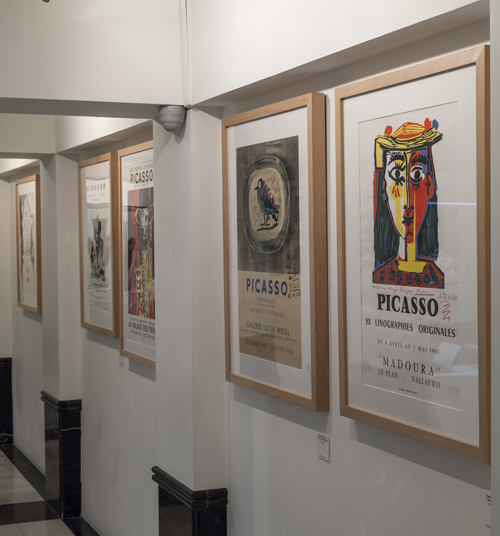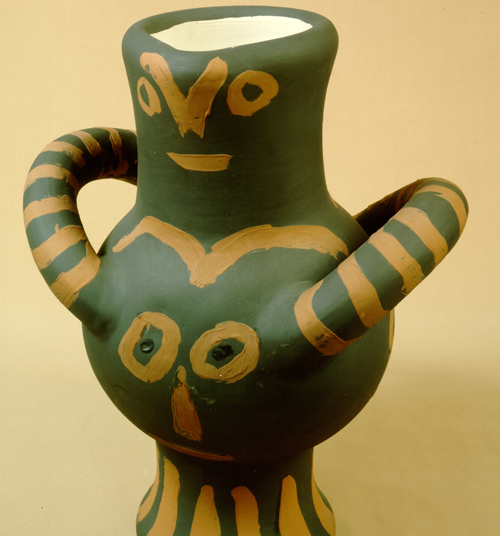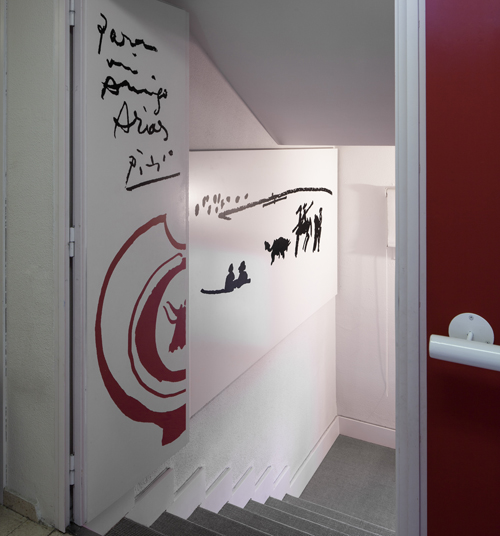
Picasso and Arias
Biographies and chronologies.
The friendship between Pablo Picasso and Eugenio Arias, born in Vallauris, France, articulates the meaning of the collection of the Picasso Museum - Eugenio Arias Collection.
This museum, dedicated to art and friendship, is a clear example of the consonances and relationships established between them, reflecting hobbies, passions and shared concerns: exile, love of bullfighting, leftist militancy, nostalgia for Spanish culture and respect and affection for the profession of barber.
Chronologies
THE PLACES OF PICASSO
Chateau de Vauvenargues:
Picasso acquires this castle, of almost monastic austerity and built in the 1958th century, in XNUMX in search of a quieter place to work.
In the gardens of this residence, located next to the Sainte-Victoire mountain, near Aix-en-Provenze and the landscapes cezannians, the remains of Picasso, who died in Mougins, find rest in 1973.
Notre Dame de Vie, Mougins:
In this residence located near Cannes, where he settled with Jacqueline after their marriage in 1961, he established his last workshop. He passes away there on April 8, 1973.
Pottery workshop "Madoura":
After moving to Vallauris, Picasso rediscovered ceramics, after making his first experiments with Paco Durrio, the Basque ceramicist friend of Gauguin, who had first introduced him to ceramic techniques in the early years of the XNUMXth century in his studio from Paris.
In the Madoura workshop, whose owners, Georges and Suzanne Ramié, he had met at the Fete des Potiers, Picasso had begun to make some ceramic tests in August 1946. A year later he began an intense activity as a ceramist, executing two thousand pieces with innovations in shapes, techniques and the use of colors.
Vallauris:
Former pottery center on the French Mediterranean coast, where in the summer of 1948 Picasso and Françoise Gilot established their definitive residence at the Villa La Galloise until 1953. From there they made sporadic visits to Paris, where the artist still kept his studio on rue Grands- Augustins. In this town, where the Eugenio Arias Barbershop and the Madoura pottery workshop are also located, Picasso experimented with new artistic techniques, with engraving and ceramics, acquiring the Fournas workshops, an old perfume factory to install ceramics, painting and sculpture.
In this city he married Jacqueline Roque in 1961 and his 1961th and 1971th anniversaries were celebrated in 80 and 90, receiving tribute from artists from all over the world.
From the close relationship between the artist and Vallauris, a secularized chapel from the 1954th century is preserved in the market square, which in XNUMX was decorated by Picasso with panels on War and Peace, transforming it into a Temple to Peace, as a response to the war from Korea.
Villa La California, Cannes:
Picasso's new residence in the Midi, acquired in June 1955, where he resides with Jacqueline until 1961.
It is a large Belle Époque building, located on the heights of Cannes, with views over Golfe-Juan and Antibes, and a large garden of palm and eucalyptus trees in which the sculptures will find a place.
Here he paints his famous "Interior Landscapes" from 1955. David Douglas Duncan, who made a book about Picasso's life in his house-workshop, which was also photographed by Edward Quinn and André Villers, evokes the place as "the most happy world" ("The private world of Picasso", 1958).
Own names
Keywords
Friendship
Since 1948, Picasso has been going to Eugenio Arias's barbershop in Vallauris, where he would enjoy the conversation with the barber, an exiled communist like himself. In the words of Eugenio Arias, Picasso was always attentive to the problems of his compatriots and tried to get to know them. "It was like a balloon of oxygen for us."
Picasso, faithful to old friendships, made Arias part of his artistic and intimate circle of friends, of which memories are also preserved in the Museum: Jacqueline Rocque, Françoise Gilot, Jean Cocteau, David Douglas Duncan, Edouard Pignon, Hélène Parmelin or Andre Villers.
Arias, exiled like Picasso himself, was his hairdresser and friend for 26 years. They barely talked about politics despite their ideological affinities. Both shared daily life: they played cards, made rounds to bars, attended bullfights, talked about Spain and Arias recited Spanish poetry to him. But the relationship between the two was broader and more complex. Arias was in charge of the artist's human relations with the outside world during the years he lived in Vallauris.
From his hairdresser, Arias received people who came to this town with the purpose of visiting the painter. He scared away the curious and tried to grant interviews with the painter to artists, bullfighters, singers or Spaniards who worked in France and wanted to meet his brilliant compatriot.
Exile
Picasso, an artist committed to the fight against Francoism, made the following explicit declarations of his anti-fascism during the War:
The Spanish War is the battle of reaction against the people, against freedom. All my life as an artist has been nothing more than a continuous struggle against reaction and the death of art. In the work I am currently working on, which I will call Guernica, I clearly express my horror at the military caste that casts a shadow over Spain in an ocean of pain and death.
Later, in 1944, he joined the Communist Party, a membership he considered a consequence of his existence and his conception of art.
The drawing of the dove drawn by Picasso and used by Louis Aragon as the image for the poster for the founding Congress of the Movement for Peace in 1949 subsequently acquires a clear anti-Francoist sign of political commitment to the defense of human rights and the demand for freedom to Spanish political prisoners.
Almost ninety percent of Picasso's life was spent outside of Spain. After the Civil War, his permanence outside his native country, until then on a voluntary basis, became political exile. In this condition he died, just two years before the beginning of the Spanish democratic transition, for which he never stopped fighting.
love of bullfighting
The passion for plazas, bullfighters and bullfighting was a constant in Picasso's life and a recurring theme in his work throughout his career. For the artist, the bullfight stages the drama of life and death and the ancestral rite that confronts man and death. Later, during his exile, the bulls also embody the depths of his deep-rooted Hispanic affiliation.
Picasso and Arias shared this great fondness for the bullfighting festival, which they attend together with some frequency in different arenas in the south of France (Arles, Céret, Collioure, Fréjus and Nimes) and they maintained friendships with bullfighters and especially with Luis Miguel Sunday.
Starting in 1951, Picasso even contributed to the establishment of a bullfighting season in Vallauris, organized by the Madrid bullfighter Paco Muñoz, for which he designed his posters.












